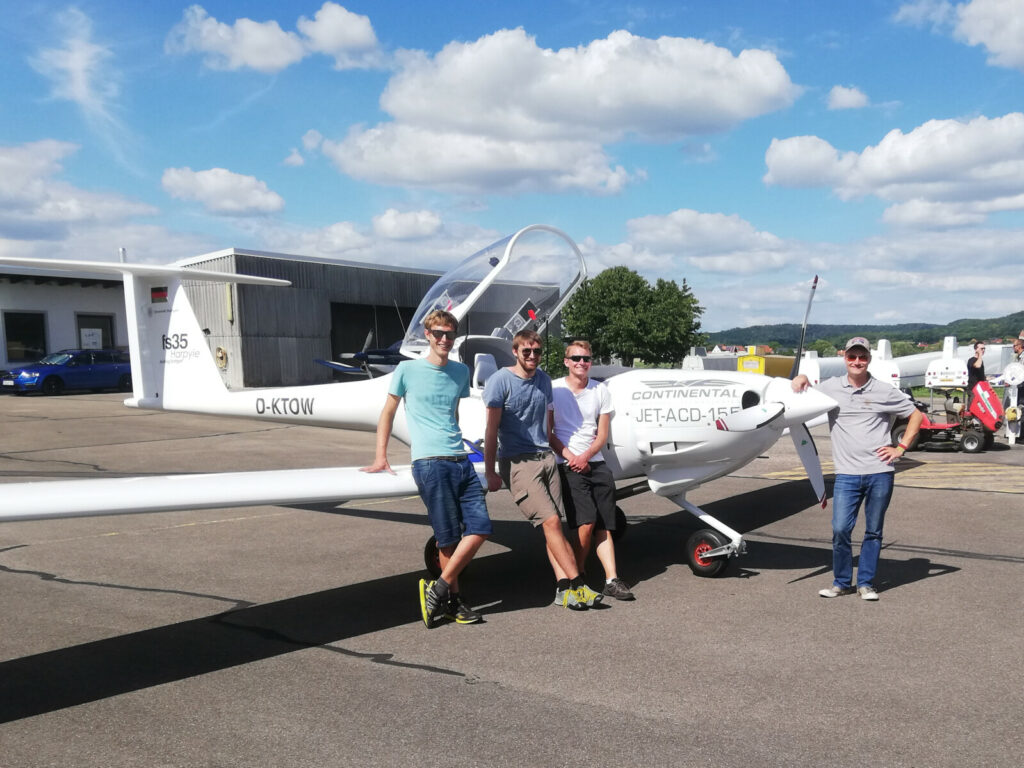
A year ago from today, the fs35 performed its first flight in Schwäbisch Hall. Many things have happened since then; the plane was ferried to Bartholomä, where it continues to be flight tested.
After the first flights this year, we started with crosswind and headwind tests, which would prevent us from being too dependent on weather conditions for flight testing. Currently, the airplane may be flown with up to 10 kt crosswind or a total wind velocity of up to 15 kt.
Subsequently, our airspeed indicator was calibrated using the GPS method. This is crucial as an accurate indicated airspeed will be necessary for following tests, such as for low-speed flying. While flights in the lower airspeed range barely had any deviation, the aircraft was 6 km/h faster than indicated when flying at 170 km/h. Such deviation is however unavoidable and approved up to a certain degree. It remains to be seen how things will look like at even higher airspeeds.

After these tests were performed and our test pilot Stefan reached a certain level of proficiency with the aircraft, we decided to start with the next phase of flight testing, namely testing the flight envelope, specifically in regards to varying takeoff weights and centers of gravity.
Due to the very nose heavy center of gravity when empty, the first flights were made with trim weights instead of the aerotow coupling. The first step afterwards was measuring the static and dynamic stability of the aircraft on the pitch axis. To measure static stability, a measuring tape was used to determine the position of the control stick during different airspeeds. This way, the aerodynamic center of the airplane with said configuration and the degree of stability. On the other hand, to measure dynamic stability, a phugoid is flown. If the airplane is dynamically stable, the phugoid will be ended after 4-5 oscillations or 22 seconds,
Furthermore, low-speed flights with signs of stall were flown in the configuration. This will then be compared to low-speed flight performance with other centers of gravity.

This program, which consisted of stall speeds and static and dynamic stability, was done systematically, starting with a more tail-heavy center of gravity and finishing off with a nose-heavy center of gravity. Center of gravity is set by adjusting the amount of fuel and trim weights carried. Depending on the location, the fs35 has a minimum speed of between 72 and 76 km/h. Following this, the approved maximum takeoff weight (MTOW) was increased frm 810 kg to 850 kg, allowing for two-seated flights.
Next on the list was training other pilots to allow for more flexibility. Two pilots will receive familiarisation and instructions on the airplane: the current head of flight testing, Michael “Hansi” Wagner, and Stefan “Zischi” Zistler of the FTAG Esslingen, who will help with aerotow testing.
In the meanwhile, engine failure tests were flown with differing airbrake settings. As part of this, the engine was shut off and restarted in the air. Punctually before the Idaflieg Summer Meet, Michael Wagner completed his familiarisation with the airplane and is then allowed to ferry the fs35 to said event in the coming weekend. We all can’t wait to see what will be tested there!


